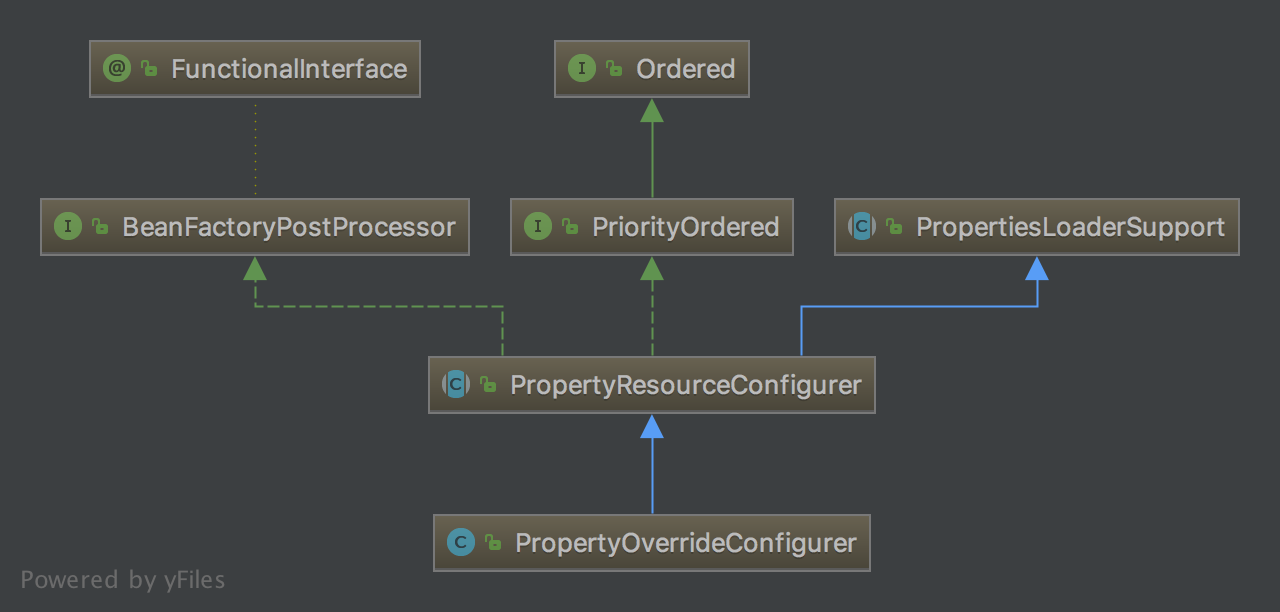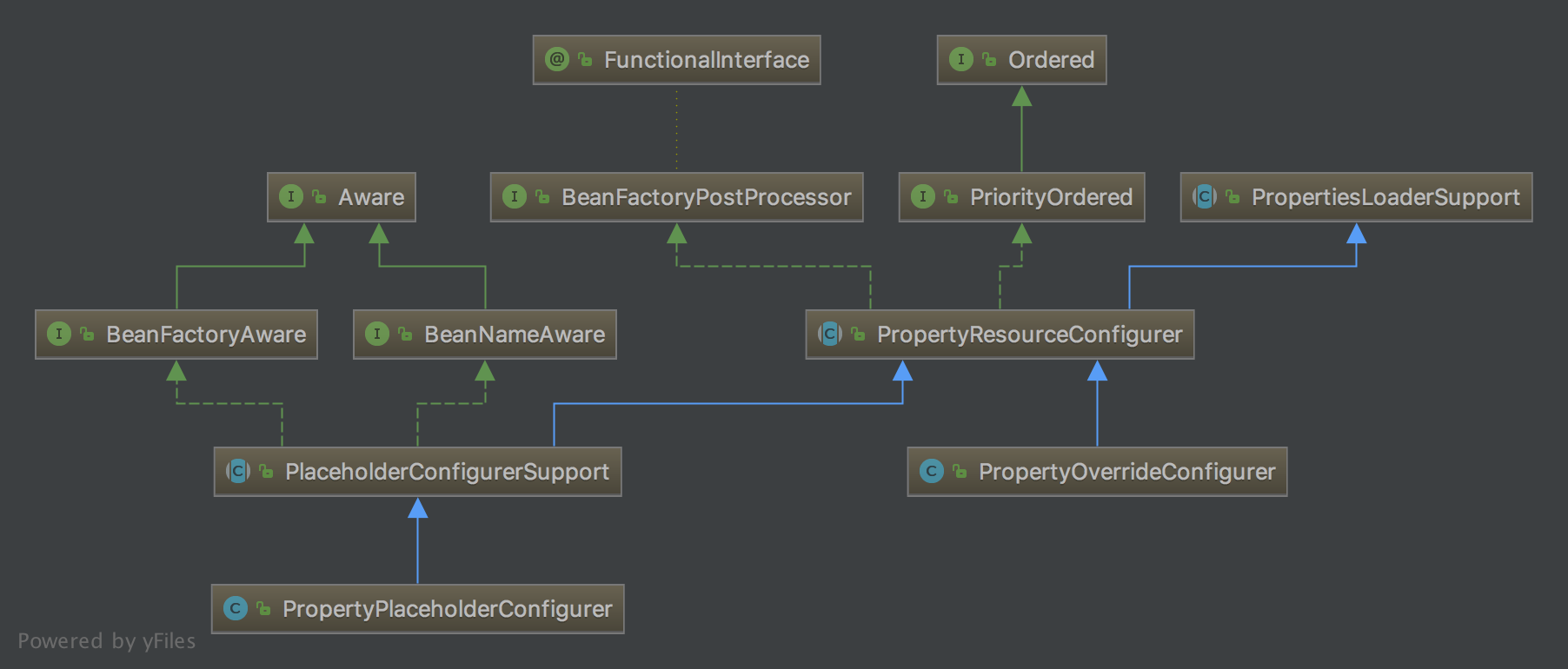在文章 【死磕 Spring】----- IOC 之 深入分析 BeanFactoryPostProcessor z中提到,BeanFactoryPostProcessor 作用与 bean 完成加载之后与 bean 实例化之前,是 Spring 提供的一种强大的扩展机制,他有两个重要的子类,一个是 PropertyPlaceholderConfigurer,另一个是 PropertyOverrideConfigurer ,其中 PropertyPlaceholderConfigurer 允许我们通过配置 Properties 的方式来取代 bean 中定义的占位符,而 PropertyOverrideConfigurer 呢?正是我们这篇博客介绍的。
PropertyOverrideConfigurer 允许我们对 Spring 容器中配置的任何我们想处理的 bean 定义的 property 信息进行覆盖替换。
这个定义听起来有点儿玄乎,通俗点说就是我们可以通过 PropertyOverrideConfigurer 来覆盖任何 bean 中的任何属性,只要我们想。
PropertyOverrideConfigurer 的使用规则是 beanName.propertyName=value,这里需要注意的是 beanName,propertyName 则是该 bean 中存在的属性
使用
依然使用以前的例子,Student.class,我们只需要修改下配置文件,声明下 PropertyOverrideConfigurer 以及其加载的配置文件。如下:
<bean class="org.springframework.beans.factory.config.PropertyOverrideConfigurer">
<property name="locations">
<list>
<value>classpath:application.properties</value>
</list>
</property>
</bean>
<bean id="student" class="org.springframework.core.service.StudentService">
<property name="name" value="chenssy"/>
</bean>
指定 student 的 name 属性值为 chenssy,声明 PropertyOverrideConfigurer 加载的文件为 application.properties,内容如下:
student.name = chenssy-PropertyOverrideConfigurer
指定 beanName 为 student 的 bean 的 name 属性值为 chenssy-PropertyOverrideConfigurer。
测试打印 student 中的 name 属性值,如下:
ApplicationContext context = new ClassPathXmlApplicationContext("spring.xml");
StudentService studentService = (StudentService) context.getBean("student");
System.out.println("student name:" + studentService.getName());
运行结果为:

从中可以看出 PropertyOverrideConfigurer 定义的文件取代了 bean 中默认的值。
下面我们看一个有趣的例子,如果我们一个 bean 中 PropertyPlaceholderConfigurer 和 PropertyOverrideConfigurer 都使用呢?那是显示谁定义的值呢?这里先简单分析下:如果PropertyOverrideConfigurer 先作用,那么 PropertyPlaceholderConfigurer 在匹配占位符的时候就找不到了,如果 PropertyOverrideConfigurer 后作用,也会直接取代 PropertyPlaceholderConfigurer 定义的值,所以无论如何都会显示 PropertyOverrideConfigurer 定义的值。是不是这样呢?看如下例子:
xml 配置文件调整如下:
<bean class="org.springframework.beans.factory.config.PropertyOverrideConfigurer">
<property name="locations">
<list>
<value>classpath:application1.properties</value>
</list>
</property>
</bean>
<bean class="org.springframework.beans.factory.config.PropertyPlaceholderConfigurer">
<property name="locations">
<list>
<value>classpath:application2.properties</value>
</list>
</property>
</bean>
<bean id="student" class="org.springframework.core.service.StudentService">
<property name="name" value="${studentService.name}"/>
</bean>
指定 PropertyPlaceholderConfigurer 加载文件为 application1.properties,PropertyPlaceholderConfigurer 加载文件为 application2.properties,student 的 name 属性使用占位符 ${studentService.name}。配置文件内容为:
application1.properties:
student.name = chenssy-PropertyOverrideConfigurer
application2.properties:
studentService.name = chenssy-PropertyPlaceholderConfigurer
测试程序依然是打印 name 属性值,运行结果如下:

所以,上面的分析没有错。下面我们来分析 PropertyOverrideConfigurer 实现原理。其实如果了解 PropertyPlaceholderConfigurer 的实现机制的话,那么 PropertyOverrideConfigurer 也不难猜测:加载指定 Properties,迭代其中的属性值,依据 “.” 来得到 beanName(split(".")[0]),从容器中获取指定的 BeanDefinition,然后得到 name 属性,进行替换即可。
实现原理
UML 结构图如下:

与 PropertyPlaceholderConfigurer 一样,也是继承 PropertyResourceConfigurer,我们知道 PropertyResourceConfigurer 对 BeanFactoryPostProcessor 的 postProcessBeanFactory() 提供了实现,在该实现中它会去读取指定配置文件中的内容,然后 processProperties() ,该方法是一个抽象方法,具体的实现由子类来实现,所以这里我们只需要看 PropertyOverrideConfigurer 中 processProperties() 中的具体实现,如下:
protected void processProperties(ConfigurableListableBeanFactory beanFactory, Properties props)
throws BeansException {
// 迭代配置文件中的内容
for (Enumeration<?> names = props.propertyNames(); names.hasMoreElements();) {
String key = (String) names.nextElement();
try {
processKey(beanFactory, key, props.getProperty(key));
}
catch (BeansException ex) {
String msg = "Could not process key '" + key + "' in PropertyOverrideConfigurer";
if (!this.ignoreInvalidKeys) {
throw new BeanInitializationException(msg, ex);
}
if (logger.isDebugEnabled()) {
logger.debug(msg, ex);
}
}
}
}
迭代 props 内容,依次调用 processKey(),如下:
protected void processKey(ConfigurableListableBeanFactory factory, String key, String value)
throws BeansException {
// 判断是否存在 "."
// 获取其索引位置
int separatorIndex = key.indexOf(this.beanNameSeparator);
// 如果不存在,. 则抛出异常
if (separatorIndex == -1) {
throw new BeanInitializationException("Invalid key '" + key +
"': expected 'beanName" + this.beanNameSeparator + "property'");
}
// 得到 beanName
String beanName = key.substring(0, separatorIndex);
// 得到属性值
String beanProperty = key.substring(separatorIndex+1);
this.beanNames.add(beanName);
// 替换
applyPropertyValue(factory, beanName, beanProperty, value);
if (logger.isDebugEnabled()) {
logger.debug("Property '" + key + "' set to value [" + value + "]");
}
}
获取分割符 “.” 的索引位置,得到 beanName 以及相应的属性,然后调用 applyPropertyValue(),如下:
protected void applyPropertyValue(
ConfigurableListableBeanFactory factory, String beanName, String property, String value) {
BeanDefinition bd = factory.getBeanDefinition(beanName);
BeanDefinition bdToUse = bd;
while (bd != null) {
bdToUse = bd;
bd = bd.getOriginatingBeanDefinition();
}
PropertyValue pv = new PropertyValue(property, value);
pv.setOptional(this.ignoreInvalidKeys);
bdToUse.getPropertyValues().addPropertyValue(pv);
}
从容器中获取 BeanDefinition ,然后根据属性 property 和 其值 value 构造成一个 PropertyValue 对象,最后调用 addPropertyValue() 方法。PropertyValue 是用于保存一组bean属性的信息和值的对像。
public MutablePropertyValues addPropertyValue(PropertyValue pv) {
for (int i = 0; i < this.propertyValueList.size(); i++) {
PropertyValue currentPv = this.propertyValueList.get(i);
if (currentPv.getName().equals(pv.getName())) {
pv = mergeIfRequired(pv, currentPv);
setPropertyValueAt(pv, i);
return this;
}
}
this.propertyValueList.add(pv);
return this;
}
添加 PropertyValue 对象,替换或者合并相同的属性值。整个过程其实与上面猜测相差不是很大。至此,PropertyOverrideConfigurer 到这里也就分析完毕了。最后看下 PropertyPlaceholderConfigurer 和 PropertyOverrideConfigurer 整体的结构图:

Java 面试宝典是大明哥全力打造的 Java 精品面试题,它是一份靠谱、强大、详细、经典的 Java 后端面试宝典。它不仅仅只是一道道面试题,而是一套完整的 Java 知识体系,一套你 Java 知识点的扫盲贴。
它的内容包括:
- 大厂真题:Java 面试宝典里面的题目都是最近几年的高频的大厂面试真题。
- 原创内容:Java 面试宝典内容全部都是大明哥原创,内容全面且通俗易懂,回答部分可以直接作为面试回答内容。
- 持续更新:一次购买,永久有效。大明哥会持续更新 3+ 年,累计更新 1000+,宝典会不断迭代更新,保证最新、最全面。
- 覆盖全面:本宝典累计更新 1000+,从 Java 入门到 Java 架构的高频面试题,实现 360° 全覆盖。
- 不止面试:内容包含面试题解析、内容详解、知识扩展,它不仅仅只是一份面试题,更是一套完整的 Java 知识体系。
- 宝典详情:https://www.yuque.com/chenssy/sike-java/xvlo920axlp7sf4k
- 宝典总览:https://www.yuque.com/chenssy/sike-java/yogsehzntzgp4ly1
- 宝典进展:https://www.yuque.com/chenssy/sike-java/en9ned7loo47z5aw
目前 Java 面试宝典累计更新 400+ 道,总字数 42w+。大明哥还在持续更新中,下图是大明哥在 2024-12 月份的更新情况:

想了解详情的小伙伴,扫描下面二维码加大明哥微信【daming091】咨询

同时,大明哥也整理一套目前市面最常见的热点面试题。微信搜[大明哥聊 Java]或扫描下方二维码关注大明哥的原创公众号[大明哥聊 Java] ,回复【面试题】 即可免费领取。

